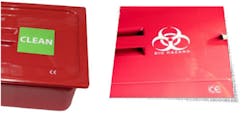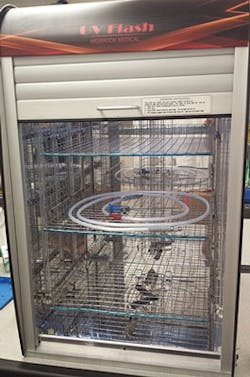Transporting clean instruments in biohazard-labeled containers; Using ultraviolet disinfection in the SPD
Submit your questions
email: [email protected]
phone: (941) 927-9345 ext. 202
Q I am the nurse manager of surgical support services at a large urban medical center that includes sterile processing. We have numerous surrounding clinics and physician offices throughout our medical center campus. These facilities send their soiled reusable instruments back to the medical center for reprocessing and sterilization.
Every day the sterile processing department (SPD) returns the sterile instruments to the various locations on an exchange basis, transporting them in special rigid containers with a secured tamper-evident lid. The containers holding the reprocessed sterile instruments are delivered to each location’s clean holding room. The clinic personnel remove the sterile items from the container bins and place them in the appropriate storage locations. Then they place the empty containers in the soiled utility room where they are used to hold soiled items for return to sterile processing for decontamination and cleaning. In other words, SPD delivers containers holding clean/sterile items in exchange for containers holding soiled items that require reprocessing. We have invested a lot of money purchasing superb containers that comply with OSHA and infection control requirements.
Here’s my dilemma: Each of the container lids has a bold, biohazard label permanently printed on it. The sterile and soiled bins are always segregated and delivered and picked up separately. They are even kept in separate compartments on specially designed transport carts. We have dedicated staff dealing with these items and all has gone well. However, we recently underwent an accreditation survey and we received a citation because the surveyor said we could not put sterile items in a container with a biohazard label on it. He did not accept our process as valid.
I now have to provide an action plan to resolve this matter. The container manufacturer cannot provide lids without the biohazard printing on them. Purchasing additional containers would be extremely costly and would require additional labor for the care and handling of a duplicate volume of containers. Do you know of any other facilities that have been confronted with such a problem? How do other facilities deal with this?
A It sounds like you have dedicated a lot of thought and resources in developing a very good system for the disposition and handling of soiled and sterile instruments to your offsite locations.
There is no doubt that the accrediting bodies are closely examining how healthcare facilities are handling, reprocessing and transporting sterile and soiled instruments and other medical devices. Transport containers and carts have to be clearly labeled and/or identifiable regarding the state of their contents (e.g., clean, soiled etc.). Over the past couple of years I have assisted many hospitals in addressing such needs and ensuring they are compliant with OSHA regulations and other professional guidelines. Your question is quite timely — yet not unique!
A couple of weeks ago I worked with a healthcare system confronting the exact same issue. We considered a number of alternatives before finding the perfect solution. We found and purchased a stock label imprinted with the word “CLEAN” in a size that fully covered the biohazard label. The label stays in place but is also easy to remove and leaves no adhesive residual when peeled off. The CLEAN label is placed over the Biohazard print on the container when the contents are clean/sterile. Once the clean processed instruments are removed the clean label is removed revealing the biohazard label and the container is placed in the soiled utility room and ready to hold the soiled goods for pick up and transport to sterile processing. (See Figure 1.)
Q I am an infection control preventionist working with the sterile processing manager to develop some process improvement initiatives. One area identified that we must address is the decontamination of medical devices and other equipment that we clean manually. Disinfecting sensitive items that cannot be soaked in a disinfecting agent or exposed to the high temperatures associated with terminal disinfection presents a problem. The manufacturer’s instructions for use (IFUs) on many of these items do not provide instructions for/nor recommend disinfection. We believe that everything should be disinfected after cleaning for the safety of workers who handle these items in subsequent reprocessing steps. Do you have any suggestions or advice?
A As an infection control professional I am sure you are very familiar with the growing application and use of ultraviolet light for the disinfection of patient care rooms, OR suites and their contents. This germicidal technology provides effective disinfection capable of destroying a wide range of germs including various bacteria, molds, yeast and viruses. This technology is now available for use in SPDs for the disinfection of items that you have described, as well as personal items such as cell phones. (See figure 2.) Many UV disinfection systems provide rapid disinfection in as little as 60 seconds of exposure. I could see this type of equipment becoming an essential tool for every sterile processing department. Placement in a pass-through window between the decontamination and clean assembly room would be an ideal process improvement initiative.

Ray Taurasi
Ray Taurasi is Principal, Healthcare CS Solutions. His healthcare career spans over five decades as an Administrator, Educator, Technologist and Consultant. He is a member of AORN, SGNA, AAMI and a past president of IAHCSMM. Taurasi has been a faculty member of numerous colleges teaching in the divisions of business administration, nursing, and health sciences. He is the author of numerous articles and textbook chapters; he is a frequent speaker at national and international healthcare conferences.
Note to readers from Ray Taurasi - In 2021, my life’s career path will transition to one of new opportunities and adventures. As a result, after nearly 19 years and 225 CS Solution columns, this edition will be my last.
“All changes, even the most longed for, have their melancholy; for what we leave behind us is a part of ourselves; we must die to one life before we can enter another.”– Anatole France
I wish you and your loved ones a healthy and joyful holiday season and a beautiful New Year! God Speed, Ray
https://www.facebook.com/pages/category/ Local-Business/Healthcare-CS-Solutions-128857 3061153887/ • email: [email protected]







